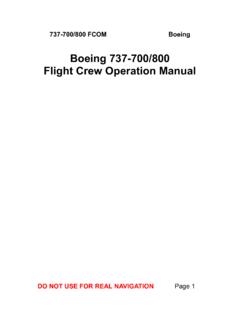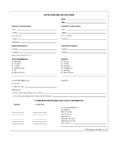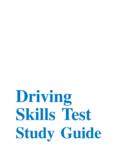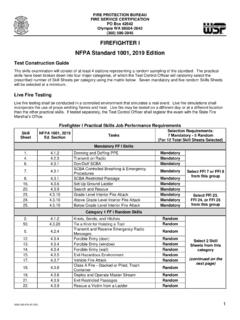Transcription of Boeing 737-700/800 Flight Crew Operation Manual
1 737-700/800 FCOMB oeingBoeing 737-700/800 Flight crew Operation Manual DO NOT USE FOR REAL NAVIGATION Page 1737-700/800 FCOMB oeingIntentionally BlankDO NOT USE FOR REAL NAVIGATION Page 2737-700/800 Director and Display Unit (CDU) Flight Director System (AFDS) and Postflight Scan of Responsibility Captain as of Responsibility First Officer as Preflight Procedure Captain or First Preflight Procedure Captain or First Procedure First Procedure Start or Towing Start Taxi Takeoff Flap Retraction Speed and Cruise Extension NOT USE FOR REAL NAVIGATION Page 3737-700/800 FCOMB oeingLanding Procedure Procedure Instrument Approach using and Missed Approach Roll Landing Procedures - Pack Operation during Engine System Manual Mode System Manual Mode Control Operation Landing at Alternate Takeoff and Engine Bleed , Heat System Approach using Vertical Speed (V/S).
2 63 Circling Power Power Power NOT USE FOR REAL NAVIGATION Page 4737-700/800 FCOMB oeingEngines, with Ground Air Source (AC electrical power available)..72 Engine Crossbleed N1 Bugs with No Operative FMC ( Manual N1 Bug Setting)..73 Fire Instruments, Airspeed Bugs with No Operative FMC ( Manual Airspeed Bug Setting)..73 Flight Management, Radar Lights Wet or Contaminated Runway Weather Procedure First Start Anti-ice Operation On the Anti-ice Operation On the Taxi Takeoff Anti-Ice Operation In Anti-ice Operation In and Landing Weather NOT USE FOR REAL NAVIGATION Page 5737-700/800 FCOMB oeingModerate to Heavy Rain, Hail or NOT USE FOR REAL NAVIGATION Page 6737-700/800 FCOMB oeingIntroductionLimitations, Normal Procedures and Supplementary Procedures based on a complete FCOM of parts of the following procedures are shorted (for example: Oxygen mask microphone ).Performance Dispatch, Performance Inflight and System Description are not use this FCOM if you are flying in areas with airports higher than 8400 NOT USE FOR REAL NAVIGATION Page 7737-700/800 FCOMB oeingLimitationsOperational LimitationsMaximum Take Off and Landing Tailwind Component15 ktsMaximum Operation Altitude 41,000 ftMaximum Takeoff and Landing Altitude 8,400 ftMaximum demonstrated take off and landing crosswind is 33 kts (with winglets) or 36 kts (no winglets).
3 Maximum difference between Captain and First Officer altitude is 75 feet. Maximum cabin pressure is Limitations737-700 WeightsPounds /KilogramMaximum Taxi Weight133,500 / 60,554 Maximum Takeoff Weight133,000 / 60,327 Maximum Landing Weight128,000 / 58,059 Maximum Zero Fuel Weigh120,500 / 54,657737-800 WeightsPounds /KilogramDO NOT USE FOR REAL NAVIGATION Page 8737-700/800 FCOMB oeingMaximum Taxi Weight133,500 / 60,554 Maximum Takeoff Weight133,000 / 60,327 Maximum Landing Weight128,000 / 58,059 Maximum Zero Fuel Weigh120,500 / 54,657 Autopilot/ Flight Director SystemDon't engage the autopilot below 400 ft single channel approach, the autopilot shall disengaged below 50 ft wind speeds for landing with autopilot (for example in case of CAT III conditions):Headwind25 ktsCrosswind20 ktsTailwind10 ktsMaximum angle for autoland: Minimum angle for autoland: Engines and APUM aximum and minimum limits are shown red in the Ignition must be on for: takeoff landing Operation in heavy rain anti ice operationDO NOT USE FOR REAL NAVIGATION Page 9737-700/800 FCOMB oeingMaximum altitude for using APU is 10,000 ftFlight ControlsMaximum altitude for flap extensions is 20,000 ftMaximum airplane speed for using speedbrakes is 300 KIASFuel SystemMaximum tank fuel temperature: 49 CMinimum tank fuel temperature: 3 C above freezing point of gas or -43 C, whichever is higherImbalance between main tank 1 and 2 must be scheduled to be zeroRandom fuel imbalance must not exceed 1000 lbs / 453 kgDO NOT USE FOR REAL NAVIGATION Page 10737-700/800 FCOMB oeingIntentionally BlankDO NOT USE FOR REAL NAVIGATION Page 11737-700/800 FCOMB oeingNormal ProceduresPhilosophyNormal procedures (NP) shall verify a satisfaction and correct Flight .
4 They shall assume that all systems operate normally. NPs also assume coordination between ground crew and cockpit. NPs do not include steps for Flight deck lightning and crew comfort CheckBefore start of a Flight check all lights to verify that all systems are running correctly. If there is any incorrect configuration verify that all system controls are set correctly. If while or after engine start a red light illuminate continue with Non Normal DutiesBefore Flight crew duties are divided between captain and first officer. In Flight duties are divided in Pilot Flying (PF) and Pilot Monitoring (PM).In general PF is responsible for: taxiing Flight path and airspeed control airplane configuration navigationIn general PM is responsible for: checklist reading communicationsDO NOT USE FOR REAL NAVIGATION Page 12737-700/800 FCOMB oeing tasks asked for by the PF monitoring the complete Flight , including taxiingPF and PM duties can change during Flight . For example, the PM can taxi the aircraft and PF can communicate in this time.
5 NPs show who does the step in headline or in every captain is the final authority for all tasks!Control Display Unit (CDU) ProceduresAll entries in CDU should be done before starting entries must verify by the other pilot. In case of changing any item in CDU the other pilot must verify them. Entries in CDU should be reduced in high workload times (Take Off or Landing). Its easier to use MCP for entries like heading or Flight Director System (AFDS) ProceduresThe crew must always monitor: course vertical path speed and thrustDO NOT USE FOR REAL NAVIGATION Page 13737-700/800 FCOMB oeingPreflight and Postflight Scan FlowDO NOT USE FOR REAL NAVIGATION Page 14737-700/800 FCOMB oeingAreas of Responsibility Captain as PFDO NOT USE FOR REAL NAVIGATION Page 15737-700/800 FCOMB oeingAreas of Responsibility First Officer as PFDO NOT USE FOR REAL NAVIGATION Page 16737-700/800 FCOMB oeingPreliminary Preflight Procedure Captain or First OfficerStart Preliminary Preflight Procedure when electrical power is on (after power up procedure or when another crew left the cockpit with power on).
6 IRS mode , then NAVV oice recorder extinguishedGPS extinguishedINTERPHONE Verify reverser lights are extinguished Verify ENGINE CONTROL lights are extinguished EEC switches - PASSENGER OXYGEN switch guard closed Verify PASS OXY ON light is gear indicator illuminatedManual gear extension access the SAFETY INSPECTION checklist on captains commandCDU Preflight Procedure Captain or First OfficerCaptain or First Officer can start the CDU Preflight Procedure any time after the Preliminary Preflight Procedure. All entries must verify by the other pilot. In general CDU Preflight Procedure will be done between Preflight data in all the boxed items on the following CDU NOT USE FOR REAL NAVIGATION Page 17737-700/800 FCOMB oeing IDENT page: Verify that the Model is correct Verify that the ENG Rating is correct Verify that the data base is correct POS INIT page: Verify that the time is correct Enter current positionNavigation Route Page: Enter ORIGIN Enter route Enter Flight NUMBER Activate and execute Route DEPARTURES page: Select runway and execute entry Verify that the route is correct.
7 Check LEGS page to avoid any problems with the Flight PERF INIT page: Enter ZFW Verify Fuel on the CDU, the papers and fuel quantity indicators Verify that gross weight and cruise CG in the CDU and the dispatch papers agree N1 LIMIT Page Select and assumed temperature, a fixed derated takeoff or both as needed Select a full or derated climb thrust as needed TAKE OFF REF page Make data entries on page 2/2 before Enter the CG Verify trim Select or enter the takeoff V speeds Verify or enter a thrust reduction NOT USE FOR REAL NAVIGATION Page 18737-700/800 FCOMB oeing Verify that preflight is completeExterior InspectionBefore each Flight captain, first officer or maintenance crew must verify that the airplane is able for a safe that nothing is damaged, full compressed and each inlet is clear of dirt. Walk along shown way and check all necessary items like engine inlets, gear and lights. In MSFS it's not necessary to do this test. Outside damages are not Procedure First OfficerFlight control NOT USE FOR REAL NAVIGATION Page 19737-700/800 FCOMB oeing Flight CONTROL switches Guards closed Verify LOW PRESSURE lights are illuminated Flight SPOILER switches Guards closed YAW DAMPER switch ON Verify YAW DAMPER light is extinguished Verify standby hydraulic LOW QUANTITY light is extinguished Verify standby hydraulic LOW PRESSURE light is extinguished ALTERNATE FLAPS master switch Guard closed ALTERNATE FLAPS position switch OFF Verify FEEL DIFF PRESS light is extinguished Verify SPEED TRIM FAIL light is extinguished Verify MACH TRIM FAIL light is extinguished Verify AUTO SLAT FAIL light is extinguishedNAVIGATION VHF NAV transfer switch NORMAL IRS transfer switch NORMALDISPLAYS SOURCE selector AUTO CONTROL PANEL select switch NORMALFuel Verify ENG VALVE CLOSED lights are illuminated Verify SPAR VALVE CLOSED lights are illuminatedDO NOT USE FOR REAL
8 NAVIGATION Page 20737-700/800 FCOMB oeing Verify FILTER BYPASS lights are extinguished CROSSFEED selector Closed Verify VALVE OPEN lights is extinguished FUEL PUMP switches OFF Verify center tank fuel pump LOW PRESSURE lights are extinguished Verify main tank fuel pump LOW PRESSURE lights are illuminatedElectrical BATTERY switch Guard closed CAB/UTIL power switch ON STANDBY POWER switch Guard closed Verify STANDBY PWR OFF light is extinguished Verify BAT DISCHARGE light is extinguished Verify TR UNIT light is extinguished Verify ELEC light is extinguished Generator drive DISCONNECT switches Guards closed Verify DRIVE lights are illuminated BUS TRANSFER switch Guard closed Verify TRANSFER BUS OFF lights are extinguished Verify SOURCE OFF lights are extinguished Verify GEN OFF BUS lights are illuminatedOverheat and fire protection Do this check only if the crew did not ELECTRICAL POWER DO NOT USE FOR REAL NAVIGATION Page 21737-700/800 FCOMB oeingUP supplementary procedure.
9 This supplementary procedure contains an overheat and fire protection check Verify that ENG no. 1. ENG no. 2 and APU fire switches are in. OVERHEAT DETECTOR switches NORMAL TEST switch Hold to FAULT/INOP Verify MASTER CAUTION lights are illuminated Verify OVHT/DET annunciator is illuminated Verify FAUL light is illuminated Verify APU DET INOP light is illuminated TEST switch Hold to OVHT/FIRE Verify fire warning bell sounds Verify master FIRE WARN lights are illuminated Verify MASTER CAUTION lights are illuminated Verify OVHT/DET annunciator is illuminated Master FIRE WARN light Push Verify FIRE WARN lights are extinguished Verify fire warning bell cancels Verify ENG 1, ENG 2 and APU fire switches stay illuminated Verify ENG 1 OVERHEAT and ENG 2 OVERHEAT lights stay illuminated Verify WHEEL WELL lights stays illuminated EXTINGUISHER TEST switch Check TEST switch Position 1 and holdDO NOT USE FOR REAL NAVIGATION Page 22737-700/800 FCOMB oeing Verify test lights are green illuminated TEST switch Release Verify test lights are extinguished Repeat for test position 2 APU switch (as needed).
10 START When APU GEN OFF BUS light is illuminated APU GENERATOR bus switches ON Verify SOURCE OFF lights are extinguished Verify TRANSFER BUS OFF lights are extinguishedEQUIPMENT COOLING Verify OFF lights are extinguishedEMERGENCY EXIT LIGHTS closed Verify NOT ARMED lights is extinguishedPassenger NO SMOKING switch AUTO or ON FASTEN BELTS switch AUTO or ONWindshield WIPER Verify windshield wipers are stowedWINDOW HEAT Position switches ON at least 10 minutes before takeoff verify OVERHEAT lights are extinguishedPROBE HEAT Verify all lights are illuminatedDO NOT USE FOR REAL NAVIGATION Page 23737-700/800 FCOMB oeingWING ANTI-ICE Verify VALVE OPEN lights are extinguishedENGINE ANTI-ICE Verify COWL ANTI-ICE lights are extinguished Verify COWL VALVE OPEN lights are extinguishedHydraulic ENGINE HYDRAULIC PUMPS switches ON verify LOW PRESSURE lights are illuminated ELECTRICAL HYDRAULIC PUMPS switches OFF Verify OVERHEAT lights are extinguished Verify LOW PRESSURE lights are illuminatedAir conditioning AIR TEMPERATURE source selector As needed TRIM AIR switch ON (737-800) Verify DUCT OVERHEAT lights are extinguished (737-700) Verify ZONE TEMP lights are extinguished (737-800) Temperature selectors As needed Verify RAM DOOR FULL OPEN lights are illuminated RECIRCULATION FAN switch(es) AUTO Air conditioning PACK switches AUTO or HIGH ISOLATION VALVE switch OPEN Engine BLEED air switches ON APU BLEED air switch ONDO NOT USE FOR REAL NAVIGATION Page 24737-700/800 FCOMB oeing Verify DUAL BLEED light is illuminated Verify PACK TRIP OFF lights are extinguished (737-700) Verify PACK lights are extinguished (737-800)






